Bread has been a cornerstone of human sustenance for millennia, but modern concerns about health and sustainability have caused many to shy away from it. However, the problem might not be bread itself, but rather the way it’s produced in today’s industrialized world.
This article revisits sourdough, a traditional form of bread celebrated not only for its health benefits but also for its potential to align with environmentally friendly and sustainable practices.
For those seeking to make better food choices – for their health and the planet – sourdough offers a compelling case for rethinking bread. And if you’re serious about making an impact, baking your own sourdough can be a meaningful step toward sustainability.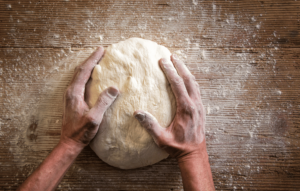
Environmental and Nutritional Benefits of Fermentation
Unlike mass-produced bread, often laden with preservatives, sugars, and commercial yeast to expedite production, sourdough is made through a natural fermentation process. This process uses wild yeast and lactic acid bacteria, which fundamentally transform both the flavor and the nutritional profile of the bread.
Sourdough fermentation reduces or completely eliminates the need for additives and preservatives, many of which are petroleum-derived or resource-intensive to produce. This not only makes sourdough healthier for humans but also less taxing on the environment.
Improved Digestibility
The long fermentation process begins breaking down the starches in flour before baking, making sourdough easier on the gut. Additionally, the natural fermentation process neutralizes phytic acid, a compound in grains that binds minerals like magnesium, iron, and zinc. By reducing phytic acid, sourdough enhances nutrient absorption, making it a more efficient use of resources for nourishment.
Lower Glycemic Impact
Sourdough bread has a lower glycemic index than conventional bread, helping to stabilize blood sugar levels. The slower digestion of sourdough reduces sugar spikes and crashes, offering sustained energy while minimizing the insulin demands that contribute to long-term health issues. Stable energy can also reduce the over-reliance on processed snacks, indirectly cutting down on waste from packaging and single-use plastics.
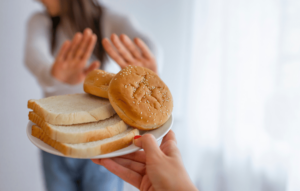
The Problem with Store-Bought Bread
Mass-produced bread exemplifies so many of the issues of industrial food production: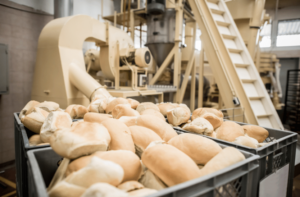
-
- Preservatives and Additives: These extend shelf life but often come at the cost of health and environmental issues.
-
- Quick-Rise Commercial Yeast: By bypassing natural fermentation, these breads lose the probiotic and prebiotic benefits of sourdough, while contributing to the homogeneity of industrial baking.
Benefits of Making Sourdough at Home
Control Over Ingredients
Homemade sourdough gives you the ability to source local flour that’s organic and use clean, chemical-free water. Supporting local farmers and reducing reliance on industrial agriculture helps cut down on the environmental toll of long-distance food transportation and pesticide use.
Reducing Food Waste
Maintaining a sourdough starter promotes a zero-waste mindset. Leftover starter can be used in recipes like crackers, pancakes, or waffles, reducing kitchen waste and encouraging resourcefulness. Additionally, sourdough bread lasts longer without the need for artificial preservatives, further reducing food waste.
A Connection to Your Food
Baking sourdough encourages mindfulness and self-sufficiency, skills that are integral to sustainable lifestyles. By engaging directly with your food, you create a deeper appreciation for the ingredients, the process, and the effort required, which can influence broader consumption habits.
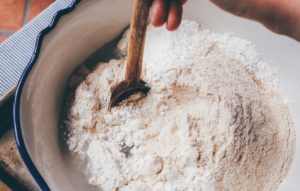
Environmental Sustainability
Choosing sourdough, particularly if you make it at home, aligns with many broader environmental goals people aspire to achieve:
-
- Reducing Reliance on Industrial Systems: Homemade sourdough bypasses the heavily processed, resource-intensive supply chains of commercial bread.
-
- Encouraging Local and Seasonal Choices: Sourcing local grains for your sourdough supports biodiversity and reduces the environmental impact of monoculture farming.
-
- Minimizing Packaging Waste: By baking at home, you eliminate the need for plastic bags and other disposable packaging associated with store-bought bread.
Conventional Bread’s Carbon Footprint
Industrial bread production leaves a significant environmental footprint. From the cultivation of monoculture wheat to the energy-intensive processes of milling, baking, and packaging, store-bought bread has hidden costs that sourdough can help mitigate.
Agriculture and Monoculture Farming
Most conventional bread relies on wheat grown in monocultures – vast fields of a single crop. While efficient for large-scale production, monoculture farming depletes soil nutrients, requires heavy pesticide use, and contributes to biodiversity loss. In contrast, sourdough recipes can incorporate heirloom or local grains such as rye, spelt, or einkorn. These grains often grow in diverse systems that promote soil health, use fewer chemicals, and support wildlife habitats.
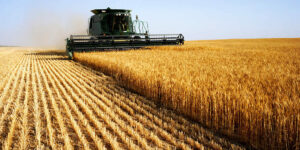
Processing and Transportation
Industrial bread is a global product. The wheat might be grown in one country, processed into flour in another, and baked in yet another, before being shipped to your local grocery store. Every stage of this process contributes to greenhouse gas emissions. By choosing sourdough – especially homemade – you reduce the environmental cost of long-distance transportation and processing.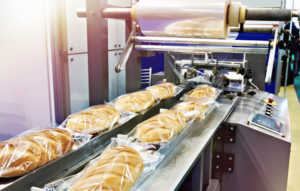
Packaging Waste
Store-bought bread is almost always wrapped in plastic, contributing to the global plastic waste crisis. Sourdough, especially when baked at home, eliminates the need for single-use plastic entirely. Even if you purchase sourdough from a bakery, you can often avoid plastic by using reusable bags or asking for paper wrapping.
A Smaller Carbon Footprint, One Loaf at a Time
Switching to sourdough may seem like a small step, but collectively, these choices can lead to a meaningful reduction in the environmental impact of bread consumption. Each homemade or locally-made loaf represents a victory for sustainability – less packaging, fewer transportation emissions, and more support for local and biodiverse agriculture.
How to Get Started
-
- Create or Obtain a Sourdough Starter: This live culture of wild yeast and bacteria is the heart of sourdough. You can make one by combining flour and water, then feeding it daily for about a week.
-
- Source High-Quality Ingredients: Look for organic, unbleached flour, and consider experimenting with heirloom grains like einkorn or spelt, which have a smaller environmental footprint than conventional wheat.
-
- Commit to the Process: Maintaining a sourdough starter requires consistent feeding, but this habit pays off with delicious, nutrient-dense bread and reduced reliance on commercial systems.
Closing Thoughts
Sourdough is more than just bread – it’s a symbol of health, sustainability, and self-sufficiency. By returning to traditional methods, we can reduce our environmental impact while nourishing ourselves more effectively.
impact while nourishing ourselves more effectively.
Whether you buy a loaf from a local bakery or bake it yourself, choosing sourdough supports a healthier body and a healthier planet. It’s a simple step with profound implications, proving that even something as humble as bread can be a force for positive change.
So, next time you’re craving bread, consider sourdough. It’s good for you, good for the environment, and – most importantly – delicious.








